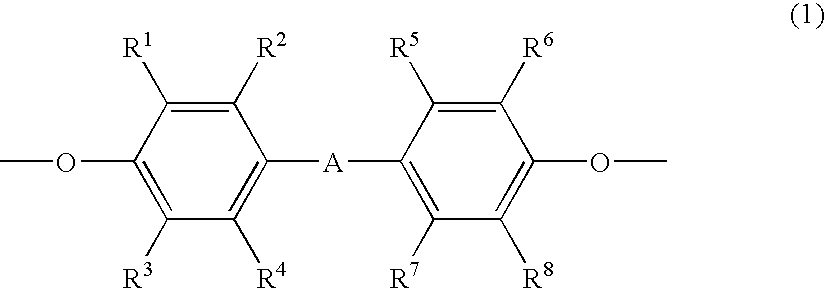Polyamide resin composition and process for producing the same
a technology of polyamide resin and composition, which is applied in the direction of film/foil adhesive, ink, inorganic insulator, etc., can solve the problems of anisotropy and thus deformation of product, inorganic particles, and product deformation, and achieve satisfactory mechanical properties, high heat resistance, and high dimensional stability
- Summary
- Abstract
- Description
- Claims
- Application Information
AI Technical Summary
Benefits of technology
Problems solved by technology
Method used
Image
Examples
synthetic example 1
[0165] Ion-exchange water, polyether compounds, and swelling mica at the weight ratios set forth in Table 1 were mixed for 15 to 30 minutes. The mixture was then dried and powdered to prepare swelling mica (Clays J-1 to J-6) treated with the polyether compounds.
TABLE 1ClayClayClayClayClayClayJ-1J-2J-3J-4J-5J-6Water100100100100100100Swelling888888mica E1Polyether41.60.80.8compoundF1Polyether2.51.64compoundF2
(unit: parts by weight)
synthetic example 2
[0166] Ion-exchange water, swelling mica, polyvinylpyrrolidone (PVP), methylstearylbis[PEG]ammonium chloride (Ethoquad produced by Lion Akzo Co., Ltd.), and trioctylmethylammonium chloride at the weight ratios set forth in Table 2 were mixed for 15 to 30 minutes. Subsequently, the mixture was dried and powdered (Clays K-1 to K-4).
TABLE 2ClayK-1Clay K-2Clay K-3Clay K-4Water100100100100Swelling mica E18888Polyvinylpyrrolidone4Methylstearylbis[PEG]8ammonium chlorideTrioctylmethylammonium46chloride
(unit: parts by weight)
examples 3 to 6
[0172] Polyamide resin A1 and the swelling mica obtained in SYNTHETIC EXAMPLE 1 at the weight ratios set forth in Table 5 were melt-mixed using a twin shaft extruder (TEX 44 produced by Japan Steel Works, Ltd.) as in EXAMPLE 1 to obtain polyamide resin compositions. The properties of the compositions were evaluated, and the results are shown in Table 5.
TABLE 5EXAMPLES3456Polyamide resin A1Parts by100Clay J-2weight57.82030Ash contentwt %4.06.013.919.2Ratio of [D]≦300 nm%90908065Average [D]nm103104140168Number of dispersedno. / wt % ·13513511285particles [N]100 μm2Average aspect ratio—13814010282Average layernm8.38.51113thicknessMaximum layernm34334865thicknessFlexural elasticMPa4010485066508030modulusFlexural strengthMPa118123130132Deflection temperature° C.108131160182under loadWarpagemm2.51.91.00.6Mold shrinkageMD%0.670.540.290.19rateTD0.680.590.320.20Centerline averagenm3.83.84.35.7roughness
PUM
| Property | Measurement | Unit |
|---|---|---|
| equivalent circular diameter | aaaaa | aaaaa |
| equivalent circular diameter | aaaaa | aaaaa |
| thickness | aaaaa | aaaaa |
Abstract
Description
Claims
Application Information
 Login to View More
Login to View More - R&D
- Intellectual Property
- Life Sciences
- Materials
- Tech Scout
- Unparalleled Data Quality
- Higher Quality Content
- 60% Fewer Hallucinations
Browse by: Latest US Patents, China's latest patents, Technical Efficacy Thesaurus, Application Domain, Technology Topic, Popular Technical Reports.
© 2025 PatSnap. All rights reserved.Legal|Privacy policy|Modern Slavery Act Transparency Statement|Sitemap|About US| Contact US: help@patsnap.com



